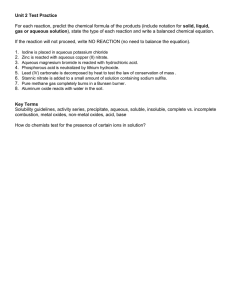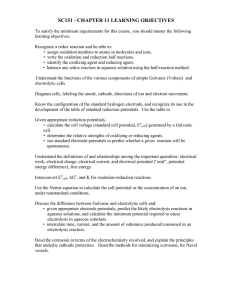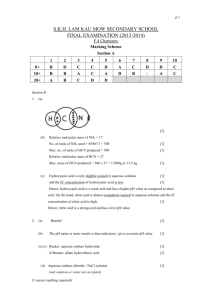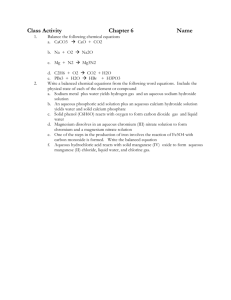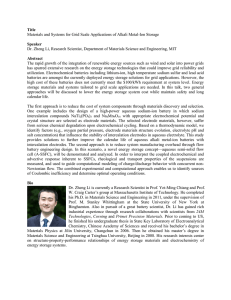A General and Efficient Method to Form Self
advertisement
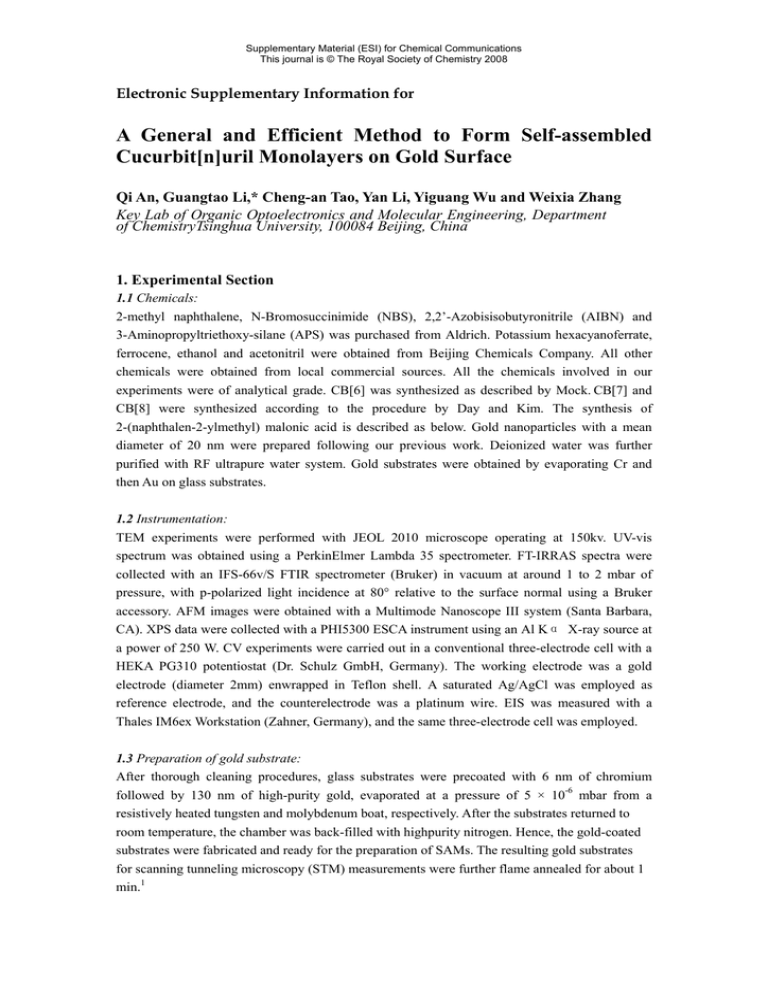
Supplementary Material (ESI) for Chemical Communications This journal is © The Royal Society of Chemistry 2008 Electronic Supplementary Information for A General and Efficient Method to Form Self-assembled Cucurbit[n]uril Monolayers on Gold Surface Qi An, Guangtao Li,* Cheng-an Tao, Yan Li, Yiguang Wu and Weixia Zhang Key Lab of Organic Optoelectronics and Molecular Engineering, Department of ChemistryTsinghua University, 100084 Beijing, China 1. Experimental Section 1.1 Chemicals: 2-methyl naphthalene, N-Bromosuccinimide (NBS), 2,2’-Azobisisobutyronitrile (AIBN) and 3-Aminopropyltriethoxy-silane (APS) was purchased from Aldrich. Potassium hexacyanoferrate, ferrocene, ethanol and acetonitril were obtained from Beijing Chemicals Company. All other chemicals were obtained from local commercial sources. All the chemicals involved in our experiments were of analytical grade. CB[6] was synthesized as described by Mock. CB[7] and CB[8] were synthesized according to the procedure by Day and Kim. The synthesis of 2-(naphthalen-2-ylmethyl) malonic acid is described as below. Gold nanoparticles with a mean diameter of 20 nm were prepared following our previous work. Deionized water was further purified with RF ultrapure water system. Gold substrates were obtained by evaporating Cr and then Au on glass substrates. 1.2 Instrumentation: TEM experiments were performed with JEOL 2010 microscope operating at 150kv. UV-vis spectrum was obtained using a PerkinElmer Lambda 35 spectrometer. FT-IRRAS spectra were collected with an IFS-66v/S FTIR spectrometer (Bruker) in vacuum at around 1 to 2 mbar of pressure, with p-polarized light incidence at 80° relative to the surface normal using a Bruker accessory. AFM images were obtained with a Multimode Nanoscope III system (Santa Barbara, CA). XPS data were collected with a PHI5300 ESCA instrument using an Al Kα X-ray source at a power of 250 W. CV experiments were carried out in a conventional three-electrode cell with a HEKA PG310 potentiostat (Dr. Schulz GmbH, Germany). The working electrode was a gold electrode (diameter 2mm) enwrapped in Teflon shell. A saturated Ag/AgCl was employed as reference electrode, and the counterelectrode was a platinum wire. EIS was measured with a Thales IM6ex Workstation (Zahner, Germany), and the same three-electrode cell was employed. 1.3 Preparation of gold substrate: After thorough cleaning procedures, glass substrates were precoated with 6 nm of chromium followed by 130 nm of high-purity gold, evaporated at a pressure of 5 × 10-6 mbar from a resistively heated tungsten and molybdenum boat, respectively. After the substrates returned to room temperature, the chamber was back-filled with highpurity nitrogen. Hence, the gold-coated substrates were fabricated and ready for the preparation of SAMs. The resulting gold substrates for scanning tunneling microscopy (STM) measurements were further flame annealed for about 1 min.1 Supplementary Material (ESI) for Chemical Communications This journal is © The Royal Society of Chemistry 2008 1.4 Preparation of citrate-gold nanoparticles: Citrate gold particles were prepared following the method previously used.[] HAuCl4 (40 mg) was dissolved in 100 mL of Milli-Q water and heated to boiling. Water (5 mL) containing 120mg of trisodium citrate was given, and the solution was refluxed for another 30 min. The resulting red sol was cooled slowly to room temperature. 2 1.5 Preparation of self-assembled CB[n] monolayer on gold surface: Prior to use, all gold substrates were cleaned with H2SO4/H2O2 (30%) mixture (3:1, v/v) for 30 seconds, rinsed with deionised water and then dried with a stream of N2. The gold substrates were incubated for 24 h at room temperature in a saturated CB[n] aqueous solution. Following this treatment, the surfaces were thoroughly rinsed with ultrapure water and absolute ethanol, and dried with high-purity nitrogen. 1.6 Electrochemical Measurements: Electrochemical measurements were performed using a traditional three-electrode glass cell with the instruments mentioned in instrument section. The gold electrode (model CHI 101, 2 mm diameter) used as the working electrode was mechanically polished with 1 μm, 0.3μm, and 0.05μm γ-Al2O3 and washed ultrasonically with deionized water. Next, it was electrochemically scanned in a 1 mM aqueous H2SO4 solution from -0.48~1.9V, and then washed and rinsed in deionized water. Finally, it was dried with high-purity nitrogen before monolayer adsorption. The monolayer was obtained by placing the thus cleaned gole electrode in 1 mM aqueous CB[7] (or aqueous saturated CB[6] or CB[8]) solution for 24 hours at room temperature. After this incubation process, the modified electrode was washed with 2 mL acetonitril, ethanol and deionized water each for 3 rounds, and then was dried with high-purity nitrogen. The supporting electrolyte is 0.1 M aqueous Na2SO4 solution. 1.7 Construction of multilayer structure using CB[n] as components: The discovered interaction between CB[n] molecules and gold could also be employed to construct supramolecular structures on substrate. Using CB[n] as molecular container and gold nanoparticle as construction component, ferrocene-containing layer-by–layer assembly was achieved by using LBL technique, as demonstrated in Scheme 1d. To facilitate the structural characterization, amino-functionalized ITO glass substrate was used in this case, instead of gold electrode. By alternately immersing modified ITO glass slit in aqueous gold nanoparticles (for 2 h) and aqueous Fc@CB[7] (CB[7] molecules with Fc in their cavities.) (for 30 min) for 5 times each, alternant AuNP and Fc@CB[7] multilayers were obtained. In this system CB[7] molecules serve as both molecular containers (hydrophobic cavity) and glue (two carbonyl-fringed portals). Figure S6 shows the UV/Vis evolution of the performed LBL self-assembly process. The plasma absorbance band of AuNP above 520 nm increased and shifted to longer wavelength range as more AuNP layers were introduced. The increased absorbance in the range of 200-300 nm indicates that more ferrocene molecules were incorporated in this multilayer system, which was also confirmed by CV study. Besides CB[7], CB[6] and CB[8] molecules could also be employed as constructing unit (nanocontainer), and thus a large variety of molecules could be introduced into the multilayer system as long as they could be included by CB[n]. Supplementary Material (ESI) for Chemical Communications This journal is © The Royal Society of Chemistry 2008 1.8 Synthesis of 2-(naphthalen-2-ylmethyl) malonic acid: COOC2 H5 Br C 2 H5 OOC COOH HOOC A mixture of 1.351g (9.5mmol) of 2-methyl naphthalene,1.619g (9.1mmol) N-Bromosuccinimide (NBS), 0.007g 2,2’-Azobisisobutyronitrile (AIBN) and 50ml CCl4 was refluxed for three hours. The warm product was filtered after the addition of 50ml CCl4. The residue was washed with the solvent several times and the product was obtained from the filter upon concentration and cooling (Yield: 70%). 1H NMR (300 MHz, CDCl3): δ = 7.09-7.82 (m, 7H, Ary-H), 4.67 (s, 2H, CH2Br). Sodium (0.05g,2mmol)was dissolved in 10ml ethanol. To this solution, 0.634g (2mmol) of malonic acid diethyl ester and 440mg (2mmol) 2 were added. The reaction mixture was stirred at r.t. for 12h. After the mixture was cooled to room temperature, ice water was added and extraction with ester was conducted. The organic layer was dried over MgSO4, filtered and concentrated. The chromatography afforded ethyl ester of the desired product as colorless oil. (Contaminated with malonic acid diethyl ester). 1H NMR (300 MHz, CDCl3): δ = 7.35-7.83 (m, 7H, Ary-H), 4.15-4.79 (q, 2H, OCH2), 3.77-3.80 (t, 1H, CH2CH), 3.37-3.42 (d, 2H, CH2CH), 1.17-1.22 (t, 3H, CH3). The obtained ester(2mmol, 602mg)and 400mg KOH were dissoloved in 30ml mixture of water and ethanol (1:2). The reaction mixture was refluxed at 90℃ for 4h and concentrated at reduced pressure. Then 30ml of ice water and 3ml of HCl (8%) was added until pH 2. The resulting white solid was filtered and dried in vacuum. (Yield: 80%). 1H NMR (300 MHz, CD3COCD3): δ = 7.43-7.81 (m, 7H, Ary-H), 3.70-3.80 (t, 1H, CH2), 3.30-3.38 (d, 2H, CH2CH). 2. Figures 2.1 We conducted the following experiment and were surprised to find that CB[n] did interact with gold. Upon addition of neutral aqueous CB[n] solution, well-dispersed aqueous AuNPs assembled. Large AuNPs clusters could be observed under transmission electron microscope (TEM) as shown in Fig. S1a-b (Fig. S1). At the same time the color of the solution turned from red to purple (Fig. S1c). As the above solution was let to stand quietly for around one hour, black precipitate of particles formed and subsided to the bottom of the reaction vessel. While adding deionised water into aqueous AuNPs solution didn’t lead to assembly event. Thus, this must be the interaction between CB[n] molecules and gold that is driving the observed assembly process. Fig. S1d displays UV/Vis spectroscopic measurement of the assembly process. When a drop of CB[7] aqueous solution was added, the intensity of the plasmon absorption of aqueous gold nanoparticles at about 520 nm kept gradually dropping as assembly process proceeded. While simultaneously, another absorption band above 600 nm appeared, strengthened and continuously shifted to longer wavelength range (Fig.S1d), indicative of the occurrence of the aggregation event of gold nanoparticles. The similar results were also observed in the cases of CB[5], CB[6] and CB[8] (Fig. S2) Supplementary Material (ESI) for Chemical Communications This journal is © The Royal Society of Chemistry 2008 Figure S1. TEM images of aqueous gold nanoparticles before (a) and after (b) the addition of one drop (4 üL) CB[7] aqueous solution; (c) photograph of the colour change of gold nanoparticles from red to purple after the addition of CB[7]; (d) UV/Vis spectrum evolution of gold particles after the addition of CB[7]. (1) curve: original gold particles; (2-7) curves: after the addition of CB[7] molecules Figure S2. TEM images of gold nanoparticles before (a) and after the addition of CB[6] (b), CB[7] (c) or CB[8] (d). 2.2 Figure 1 (in main text) shows the FT-IRRAS spectrum of the prepared CB[7] SAM. Two Supplementary Material (ESI) for Chemical Communications This journal is © The Royal Society of Chemistry 2008 characteristic peaks of CB[7] at 1751 cm-1 and 1474 cm-1 corresponding to C=O and C-N stretching vibrations, respectively, were clearly detected, indicating the existence of CB[7] molecules on gold surface. Compared with infrared spectrum of CB[7] obtained using bulk KBr pellet (see Fig. S3), the more intense peak at 1751 cm-1 (amide I) suggests that a large fraction of CB[7] molecules rest with their carbonyl groups perpendicular with respect to the gold surface, in accordance with the FT-IRRAS surface selective rule. absorption (a.u.) 100 80 60 40 20 0 500 1000 1500 2000 2500 3000 3500 Wave numbers (cm-1) Figure S3. FT-IR spectrum of CB[7] obtained using KBr pellet. Figure S4. CVs of (a) bare electrode, (b) CB[n] modified and (c) Fc@CB[n] modified electrode in 0.1 M aqueous solution of K2SO4 at the san rate of 1.0 v/s. 2.3 Other molecules that bind CB[n] in bulk solution could also be recognized by surface-confined CB molecules. As a demonstration, the recognition of electroinactive substituted naphthalene Supplementary Material (ESI) for Chemical Communications This journal is © The Royal Society of Chemistry 2008 molecule (see Scheme 1) by the attached CB[7] receptor was examined using electrochemical impedance spectroscopy (EIS). Figure S5 shows the EIS spectra of the modification and recognition processes. Figure S5. Nyquist plots of a bar Au electrode (△), CB[7] modified electrode ( O ) and CB[7] modified electrode after the immersion of substituted naphthalene solution (■) in a 1.6 mM [Fe(CN)6]3-/4- (1:1) mixture as redox probe in aqueous 0.1 M K2SO4 solution. Applied potential was 250 mV versus Ag/AgCl. The experimental data were fitted to the inserted circuit. Rs: solution resistance; Rct: Charge transfer resistance; W: Warburg impedance; Cd: capacitor representing double layer. References 1. 2. Y. Jiang, Z. Wang, H. Xu, H. Chen, X. Zhang, M. Smet, W. Dehaen, Y. Hirano, Y. Ozaki, Langmuir 2006, 22, 3715. G. Li, M. Lauer, A. Schulz, C. Boettcher, F. Li, J.-H. Fuhrhop, Langmuir 2003, 19, 6483.
